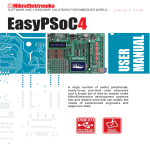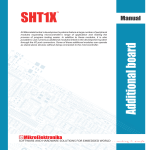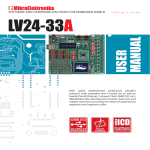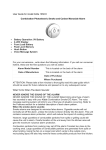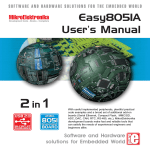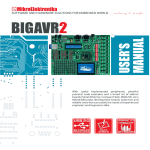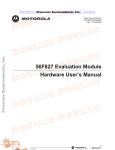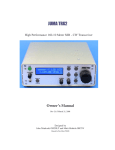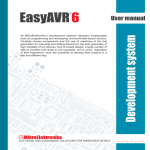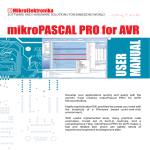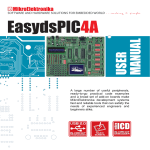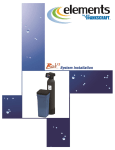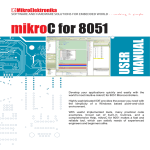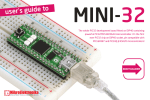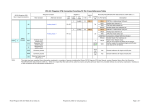Download dsPICPRO4 User Manual
Transcript
CONTENTS dsPICPRO4 KEY FEATURES CONNECTING THE SYSTEM INTRODUCTION Switches and Jumpers MCU Sockets Power Supply On-Board USB 2.0 Programmer MikroICD RS-232 Communication Circuit Ethernet DS1820 Digital Thermometer DAC Real Time Clock (RTC) RS-485 Communication CAN Circuit LEDs Push Buttons 2x16 Character LCD Graphic LCD Touch Panel A/D Converter Test Input Direct Port Access Connectors MMC/SD (Multimedia Card) 4 5 6 7 8 10 11 12 13 14 16 17 18 19 20 21 22 23 24 25 26 27 28 4 DSPICPRO4 KEY FEATURES 1. 2. 3. 4. 5. 6. 7. 8. 9. 10. 11. 12. 13. 14. 15. External power supply 9-32V AC/DC; On-Board USB 2.0 Programmer with MikroICD support; RS232-A connector; RS232-B connector; Reference voltage source 4.096V; On-board serial ethernet module; LCD 2x16 connector; LCD contrast potentiometer; A/D converter test inputs; DS1820 temperature sensor connector; Resistor pull-up/pull-down net 8x10K; Real time clock; DAC module; RS485 module; CAN module; 16. Each LED corresponds to one MCU pin; 17. DIP switch SW1used to enable/disable LEDs; 18. dsPICPRO4 supports 64 and 80-pin microcontrollers and comes with 80-pin microcontroller dsPIC30F6014A; 19. DIP switches SW2-SW5 are used to enable/disable on-board peripherals; 20. Direct ports access connectors; 21. MMC/SD multimedia card slot; 22. RESET button circuit; 23. Push buttons; 24. Touch panel connector; 25. GLCD connector; 26. GLCD contrast potentiometer; 27. Touch panel controller; and 28. Pull-up/pull-down jumper. Apart from this manual, the development system box contains development system, product CD, USB cable, RS232 cable and Installing USB drivers manual. In order to use the dsPICPRO4 properly, it is necessary to go through the following steps: Step no.1 Take the development system and product CD out of the box. Insert the product CD into CD drive. Please, do not connect the development system to a PC yet. Step no.2 Install dsPIC flash programmer software to enable a program to be transferred from PC to the microcontroller chip. Step no.3 Install USB drivers on your PC to enable programmer's hardware to operate properly on the dsPICPRO4 board. For detailed installation instructions refer to the 'Installing USB drivers' manual. Step no.4 Connect the dsPICPRO4 to PC using USB cable. Please use one of USB ports on the back of the PC because they are directly connected to the computer motherboard. The first time you switch the dsPICPRO4 on, your PC will automatically detect a new hardware. You will be immediately prompted whether Windows should search for new drivers update or not. Select the option 'No, not this time' and click 'Next'. Another window appears, click 'Next' and the operating system will automatically find drivers. Click 'Finish' to complete this process and run dsPICflash. Next time you switch the dsPICPRO4 on, Windows will not ask for new drivers update during driver installation. . After these four steps, your dsPICPRO4 is successfully installed and ready for use. You can read a program from the chip or write a new one into it. The product CD provides numerous simple program examples to make your first steps Easy... . 5 CONNECTING THE SYSTEM CONNECTING THE SYSTEM INTRODUCTION 6 INTRODUCTION The dsPICPRO4 development system is a full-featured development board for dsPIC Microchip microcontrollers. It is designed to allow students and engineers to easily test and explore the capabilities of dsPIC microcontrollers. It also allows dsPIC microcontrollers to be interfaced with external circuits and a broad range of peripheral devices. The user can therefore concentrate on software development only. Figure 1 illustrates the development board. There are identification marks next to each component on a silkscreen, both on the top and bottom. These marks describe connections to the microcontroller, operation modes, and provide other useful information so that there is almost no need for additional schematics. Figure 1 dsPICPRO4 development board SWITCHES The dsPICPRO4 development system features a number of peripheral devices. In order to enable them before programming, the appropriate jumpers or switches have to be properly set. Switches are mechanical devices used to establish or break connection between two contacts. The dsPICPRO4 development system has five groups of switches. Figure 2 Switch group SW5 Switches 1, 2, 3 and 4 are ON, whereas 5, 6, 7 and 8 are OFF DIP switch SW1 enables/disables LEDs; DIP switch SW2 enables/disables LCD,GLCD-BCK, CAN, RS-485 and RTC-INT; DIP switch SW3 enables/disables touch panel controller and ethernet; DIP switch SW4 enables/disables MMC-CS, DAC, SPI and I2C; and DIP switch SW5 enables/disables PORTB_HIGH pull-up/pull-down resistors. JUMPERS Similarly, jumpers are used to break or establish connection between two points. Under the plastic cover of a jumper, there is a metal contact which establishes connection when the jumper is placed over two pins. Jumper is commonly used as a selector between two possible connections via 3-pin connector. As illustrated in Figure 3, the middle connector pin can be connected to the left or right pin, depending on the jumper’s position. Jumper is not placed and middle pin is unconnected. Figure 3 Jumper as a selector Jumper is placed on the right side connecting middle and right pin. Jumper is placed on the left side connecting middle and left pin. SWITCHES AND J UMPERS 7 MCU SOCK ET 8 MCU SOCKET The dsPICPRO4 comes with an 80-pin dsPIC30F6014A microcontroller in TQFP soldered on MCU card. The user can remove this MCU card and fit another one with either 64 or 80-pin microcontroller on it. Figure 4 MCU card When placing MCU card in the dsPICPRO4 MCU socket, it is necessary to follow the steps below: Step no. 1 Step no. 2 Step no. 3 If MCU card is already placed on the dsPICPRO4, it is necessary to remove it by slowly pulling it up. Place another MCU card on the board. Note that label on the MCU card must be in the upper left corner as labelled on the dsPICPRO4 board. When the MCU card is properly placed, push it down by applying pressure on all edges at the same time. All port pins are connected to LEDs and push buttons, which allows you to easily monitor and test digital pin state. Some of the pins are connected to other peripherals such as DS1820 temperature sensor circuit, RS-232 communication circuit, RS-485 communication circuit, LCD etc. Figure 5 MCU system connection 9 MCU SOCK ET The microcontroller pins are routed to various peripherals as illustrated in Figure 5. All ports have direct connections to Direct Port Access 2x5 (10-pin) connectors. These connectors are typically used for connecting external peripherals to the board or as points for digital logic probe connecting. POWER SUPPLY The dsPICPRO4 can use one out of two power supply sources - regulated PC supply over USB cable (by default) and external power supply (external AC/DC power adapter). When using power supply over USB cable, the jumper J10 should be set in the right-hand position. POWER SUPPLY 10 When using external power supply, the dsPICPRO4 board produces +5V using MC34063A voltage regulator. The external power supply can be AC or DC, while power supply voltage ranges from 9V to 32V. The jumper J10 should be set in the left-hand position. Figure 7 illustrates USB and external power supply circuits. Figure 6 Power supply Figure 7 Power supply circuit diagram J1 in the left-hand position: system is powered from external AC/DC power adapter. J1 in the right-hand position: system is powered from PC over USB cable. There is no need to use external equipment during programming as the dsPICPRO4 development system has its own on-board USB 2.0 programmer. All you need to do is to connect the system to PC using the USB cable. Then, load your program into the microcontroller via the dsPICflash programming software supplied with the dsPICPRO4. Please refer to dsPICflash documentation for more information. Figure 8 Figure 9 Note: USB 2.0 programmer USB 2.0 programmer circuit diagram There is no need to reset MCU after programming because the programmer will automatically reset it. 11 ON-BOARD USB 2.0 PROGRAMMER ON-BOARD USB 2.0 PROGRAMMER MIK ROICD (HARDWARE IN-CIRCUIT DEBUGGER) 12 MIKROICD (HARDWARE IN-CIRCUIT DEBUGGER) MikroICD is a highly effective tool for Real-Time debugging on hardware level. The mikroICD debugger enables you to execute a program on dsPIC microcontroller and view variable values, special function registers (SFRs) and EEPROM while the program is running. MikroICD can be used with any dsPIC compiler designed by MikroElektronika (mikroC for dsPIC, mikroBasic for dsPIC or mikroPascal for dsPIC). You just have to select the appropriate build type (Release or ICD Debug), build a project, program the MCU and run debugger. The mikroICD debugger uses on-board programmer to communicate with the compiler and supports common debugger commands: Start Debugger Run/ Pause Debugger Toggle Breakpoints Run to cursor Step Into Step Over Flush RAM Stop Debugger [F9] [F6] [F5] [F4] [F7] [F8] [F2] [Ctrl+F2] Figure 10 MikroICD circuit diagram Note: For more information on how to use mikroICD debugger please refer to the mikroICD documentation mikroICD User’s Manual. You can also find it in Help documentation inside any compiler mentioned. RS-232 COMMUNICATION RS-232 communication enables point-to-point data transfer. It is commonly used in data acquisition applications to transfer data between the microcontroller and PC. Since the voltage levels of the microcontroller and PC are not directly compatible with each other, a level converter such as MAX232, must be used. In order to provide more flexible system, the microcontroller is connected to MAX232 via jumpers J12 and J13 for RS-232A and jumpers J14 and J15 for RS-232B. The jumpers J12 and J13 are therefore used to connect Rx and Tx lines to RF2 and RF3 pins, whereas the jumpers J14 and J15 are used to connect Rx and Tx lines to RF4 and RF5 pins. Figure 11 RS-232 communication Figure 12 RS-232 communication circuit diagram 13 ETHERNET 14 ETHERNET Ethernet is most commonly used Local Area Network (LAN) technology today. On the top of physical layer, Ethernet stations mutually communicate by sending data packets to each other. Each station is assigned a single 48-bit MAC address which is used to specify both destination and source of each data packet. Ethernet has 28-pin ENC28J60 10BASE-T Ethernet Controller with on-board Media Access Control and Physical Layer (MAC & PHY), 8KB of Buffer RAM and Serial Peripheral Interface (SPI) communication. Figure 13 Ethernet DIP switches SW3 and SW4 are used to enable/disable serial ethernet communication as shown in Figure 14. ETHERNET 15 Figure 14 Ethernet circuit diagram 16 DS1820 DIGITAL THERMOMETER DS1820 DIGITAL THERMOMETER The DS1820 digital thermometer is well-suited to environmental temperature measurement, having a temperature range of -55Co to 125Co and accuracy of +/-0.5Co. It must be properly placed in the 3-pin socket provided on the dsPICPRO4, with its rounded side facing to the top, as marked on the board (see Figure 15). Otherwise, the DS1820 could be permanently damaged. The right position of DS1820 is marked on the silkscreen Figure 15 DS1820 digital thermometer Figure 16 DS1820 digital thermometer circuit diagram DAC The dsPICPRO4 development system has an on-board 12-bit D/A converter MCP4921 used to perform digital-to-analog conversion. After conversion, the appropriate analog value appears on the connector CN17. Similar to A/D converter unit, the dsPICPRO4 also enables reference voltage selection for the operation of MCP4921 converter. The appropriate voltage is selected using the jumper J16. The operation of this converter as well as its communication with the microcontroller is enabled by switches 2, 3, 4 and 6 of the DIP switch SW4. Figure 17 DAC Figure 18 DAC circuit diagram DAC 17 REAL TIME CLOCK (RTC) 18 REAL TIME CLOCK (RTC) Most hardware projects need a real time clock or a delay source. For this reason, the dsPICPRO4 development board is provided with PCF8583P. It is a Real Time Clock Chip that uses I2C serial communication to exchange data with the microcontroller and has one interrupt output. In order that it works properly, both interrupt and I2C communication lines must be connected to the microcontroller by using switch 8 of the DIP switch SW2 and switches 7 and 8 of the DIP switch SW4. Figure 19 Real time clock Figure 20 Real time clock circuit diagram RS-485 communication circuit enables point-to-point data transfer. It is commonly used for data transfer between several microcontrollers. ADM485 interface transceiver is used to transform a signal on microcontroller’s Rx and Tx lines into a differential signal on A and B output lines. Figure 21 RS-485 communication The dsPICPRO4 development board has one RS-485 communication circuit. In order to provide more flexible system, the microcontroller is connected to ADM485 via three switches (5,6 and 7) of the DIP switch SW1. These switches are also used to connect microcontroller lines Rt, Rx and Tx to RS-485. Figure 22 RS-485 communication circuit diagram 19 RS-485 COMMUNICATION CIRCUIT RS-485 COMMUNICATION CIRCUIT CAN 20 CAN CAN (Controller Area Network) is a serial network initially designed for the automotive industry, but has also become a popular bus in industrial automation as well as in other applications. CAN is a two-wire, half-duplex, high-speed network system established among microcontrollers. Halfduplex indicates that the microcontroller can send and receive data, but either of them at a time. The dsPICPRO4 development board has one CAN communication circuit whose Rx and Tx lines are enabled via switches 3 and 4 of the DIP switch SW2. Figure 23 CAN Figure 24 CAN circuit diagram LEDs Light Emitting Diodes (LEDs) are components most commonly used for displaying pin digital state. The dsPICPRO4 has 67 LEDs connected to the microcontroller ports: PORTA, PORTB low, PORTB high, PORTC, PORTD low, PORTD high, PORTF, PORTG low and PORTG high. You can enable/disable port LEDs using the appropriate switch of the DIP switch SW1. Figure 25 LEDs Figure 26 PORTA LEDs circuit diagram LEDS 21 PUSH BUTTONS The dsPICPRO4 has 67 push buttons which can be used to provide digital inputs to the microcontroller ports. There is also one red push button that acts as a RESET button. PUSH BUTTONS 22 Figure 28 illustrates connection between push buttons and PORTA. Remember that there are another eight ports, not shown on this circuit diagram, but are connected to push buttons the same way as PORTA. Figure 27 Push-buttons Figure 28 Push-buttons circuit diagram 2X16 CHARACTER LCD Figure 29 2x16 LCD in 4-bit mode Figure 30 2x16 LCD circuit diagram Note: Bear in mind that LCD should be placed or removed from the dsPICPRO4 only after the power supply is switched off. Otherwise, it could be permanently damaged. 2X16 CHARACTER LCD A standard character LCD is probably most widely used data visualization component. It can normally display messages in two lines containing up to 16 alphanumeric characters each. Every character is made up of 5x8 pixels. The character LCD communicates with the microcontroller via 4-bit data bus. Its connection to the microcontroller is shown in Figure 30. 23 GRAPHIC LCD 24 GRAPHIC LCD A graphic LCD (GLCD) provides an advanced method for displaying visual messages. While a character LCD can display only alphanumeric characters, a GLCD can be used to display messages in the form of drawings and bitmaps. Most commonly used graphic LCD has a screen resolution of 128x64 pixels. The GLCD contrast can be adjusted using the potentiometer P2 placed in the upper right corner of GLCD. Figure 31 GLCD Figure 32 GLCD circuit diagram Note: Bear in mind that GLCD should be placed or removed from the dsPICPRO4 development board only after the power supply is switched off. Otherwise, it could be permanently damaged. TOUCH PANEL Touch panel is a thin self-adhesive, transparent panel that could be placed over screen of graphic LCD. It consists of two separate foils forming a “sandwich” structure. It is very sensitive to press so that even a soft touch causes some changes on output signal. It is used in various user-friendly devices in combination with graphic LCD. Connector CN1 enables this device to be connected to on-board touch panel controller the active part of which consists of 5 discrete transistors. Four switches of the DIP switch SW3 enable or disable connection between this controller and RB8, RB9, RF0 and RF1. Figure 33 Touch panel Figure 34 Touch panel controller Figure 35 Touch panel circuit diagram TOUCH PANEL 25 A/D CONVERTER TEST INPUTS 26 A/D CONVERTER TEST INPUTS The dsPICPRO4 development board has two potentiometers for demonstrating the operation of analog-to-digital converter (ADC). Both potentiometer outputs are in the range of 0-5V. These analog signals can be connected to two different analog input pins simultaneously. Jumpers J17 and J18 are used for connecting potentiometers P3 and P4 to the appropriate MCU pins. Figure 36 A/D converter test inputs A/D conversion has a wide range of applications. The microcontroller takes an analog signal from its input pin and converts it into a digital value. Basically, it is possible to measure any analog signal that fits in the range acceptable by the microcontroller. As for the dsPICPRO4, this range is 0 - 5V. Figure 37 A/D converter test inputs circuit diagram All microcontroller input/output pins can be accessed via IDC-10 connectors (2x5) placed along the right side of the board. For each microcontroller port there is one connector providing up to eight port pins and two additional pins connected to VCC and GND. Figure 39 Direct port access flat cable connection Figure 38 Direct port access connectors These connectors can be used to connect the system to external devices. If on-board and external peripherals use the same pins then on-board peripherals must be disconnected from the microcontroller by setting the appropriate jumpers. The connectors can also be used for attaching logic probes or other test equipment. Figure 40 Direct port access circuit diagram 27 DIRECT PORT ACCESS DIRECT PORT ACCESS CONNECTORS MULTIMEDIA CARD (MMC/SD) 28 MULTIMEDIA CARD (MMC/SD) MMC card is used as a data storage media for portable devices. With MMC reader you can easily transfer data from MMC card to your computer. Microcontroller on the dsPICPRO4 communicates with Multi Media Card via SPI communication. Figure 41 MMC/SD (multimedia card) To enable MMC card you must turn on switches 1, 4, 5 and 6 of the DIP switch SW4. In this way, MMC’s Chip Select (MMC-CS) and SPI communication lines (SCK, MISO and MOSI) are connected with the microcontroller. The operating voltage of dsPICPRO4 is 5V DC, whereas that of MMC card is 3.3V DC. For this reason, there is an on-board voltage regulator provided with MMC card (MC33269DT-3.3). Data lines connecting microcontroller and MMC card must also be adjusted to 3.3V. It is done using resistor voltage dividers shown in Figure 42. Precise reference voltage source 3.3V Figure 42 MMC/SD circuit diagram MULTIMEDIA CARD (MMC/SD) 29 Reset circuit MMC/SD slot CAN (Controller Area Network) circuit RS485 communication circuit DAC (Digital-toAnalog converter) LEDs are connected to MCU pins Turn ON/OFF the LEDs on ports A, B, C, D and E as well as LCD and GLCD backlights Real time clock 2x16 LCD display 2x16 LCD display contrast potentiometer ON/OFF switch Choose between external and USB power supply. When using USB port, there is no need for external power supply. Buttons to activate pins high/low state dsPICPRO4 supports microcontrollers with 64 and 80 pins in TQFP Touch panel ribbon cable GLCD with touch panel Touch panel controller USB communication Very fast and flexible RS232 communication port Reference voltage A/D converter Ethernet circuit USB 2.0 programmer with selectable TX and RX source 4.096V connector test inputs Jumper to select high/low state of the input pins when the button is pressed External power supply 8 - 16 V AC/DC DSPICPRO4 GLCD contrast potentiometer DIP switches SW2-SW4 used to enable/disable on-board components IDC10 port connector (5x2) for MCU pin out Temperature sensor connector for DS1820
































